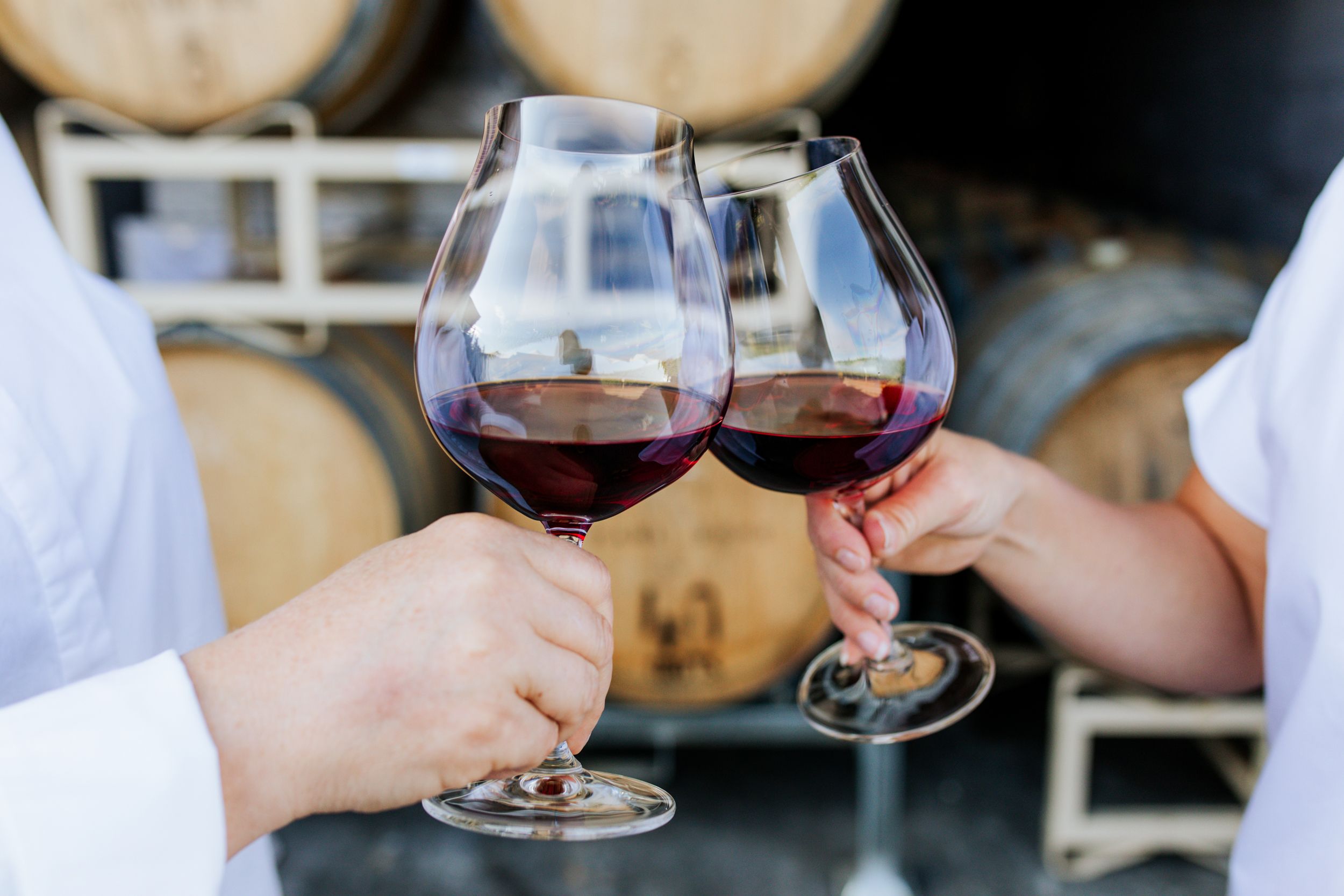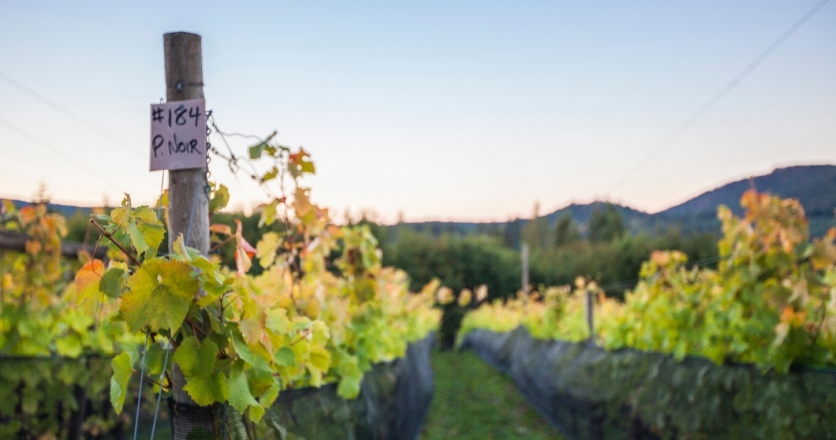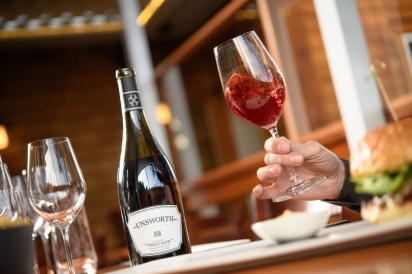Pinot’s Potential
Bright red fruit and a seductive fragrance. A hint of spice. A touch of earthiness.
That’s Vancouver Island Pinot Noir, a delightfully drinkable, food-friendly wine that’s so popular these days it’s hard to believe that until a few years ago, hardly any Pinot Noir was grown on the Island at all. “It was like a unicorn,” says Bailey Williamson, winemaker at Blue Grouse Estate Winery in the Cowichan Valley.
But all that’s changing, and fast. Today, according to Wine Growers BC, 20% of the 277 acres of vineyards from Comox to Saanich are planted to Pinot Noir, with more to come. “The challenges can be great, but the rewards are just as great,” Williamson says. “It’s the heartbreak grape, so when you do get it right it’s exciting.”
The noblest of the noble varieties
Pinot Noir is one of the so-called “noble grape” varieties, grown for at least 2,000 years in its home of Burgundy, France. It is a black grape with tightly packed, thin-skinned berries that produce some of the planet’s most highly prized wines in places like New Zealand and Oregon.
The Island’s first Pinot vines were likely planted as part of the Duncan Project (also known as the Becker Experiment), a government-funded initiative in the 1980s to see what, if any, wine grapes could grow in the Cowichan Valley. Mostly what thrived were non-Vitis vinifera hybrids and crosses like Ortega, Bacchus and Marechal Foch.
Then in 2001, Andy Johnston opened Averill Creek Vineyard just outside Duncan. Twenty years later, he is more convinced than ever that the Island, and especially the Cowichan Valley, can produce exceptional Pinot Noir.
“This is the Domaine de la Romanée-Conti of Canada,” Johnston says, referring to the Burgundian estate that produces some of the world’s best—and most expensive—Pinot Noir. To prove his point, Averill Creek’s 2018 Barrel 24 Pinot Noir is selling for $120 a bottle, one of the most expensive wines produced in B.C.
“Our problem is we can’t keep up with demand and you can’t buy grapes on the Island,” Johnston adds. “We’re now shipping two-thirds of our wine into Vancouver. Vancouver and the Lower Mainland have taken to Island wines like crazy.”
Since 2001, other Island wineries have planted Pinot, including 40 Knots Winery in Comox, Chateau Wolff Estate in Nanaimo, and Saison Market Vineyard in Duncan, which in 2008 planted several Dijon clones (cuttings of Burgundian Pinot Noir that can be grafted onto existing rootstocks). That was when things really started to change.
In 2009, Tim and Colleen Turyk bought the Cobble Hill property that would become Unsworth Vineyards and started making Pinot Noir still and sparkling wines. Then in 2012, Paul Brunner bought Blue Grouse, one of the Valley’s oldest wineries, which was producing a trickle of Pinot from a mystery clone that was likely a remnant of the Duncan Project.
Averill Creek, Unsworth and Blue Grouse have all been planting a lot more Pinot Noir. As Williamson says, “We really thought Pinot Noir had a lot of potential as the noblest of the noble varieties.”
An exotic terrain
But before Island Pinot could reach that potential, its producers had to understand their terroir (the combination of climate, soils and terrain that affect the taste of wine).
Grapes are grown in Port Alberni, Comox, several Gulf Islands and Saanich, with most Island wine coming from the Cowichan Valley, where some 175 acres are planted to vine. Its unique terroir—and the work Brunner especially has invested in mapping it—helped the region become certified as B.C.’s newest sub-geographical indication in July 2020.
Climate-wise, this is the very limit of where Pinot Noir can be grown. Although Cowichan has Canada’s highest annual temperature year-round, it does not have the kind of intense summer heat grapes need to develop big, bold flavour. It is also more humid than is ideal for Pinot, whose thin skin makes it vulnerable to disease (which is why it’s known as the “heartbreak grape”). “It’s well suited to the region, but it’s not easy by any means because of the high moisture,” Williamson says.
The soil, on the other hand, is thrillingly diverse.
“Vancouver Island is a geologic remnant of what’s known as an exotic terrain,” explains Brunner. The Island was created by a combination of geologic events including volcanic activity and glaciation, and was at one time an ancient seabed. Its soil is a combination of silt-loams, clay loams, gravel, limestone and other complex soil types that include marine remnants, basalt boulders and a layer of sediment up to five kilometres thick.
Because of all this, Cowichan Valley Pinot has a distinctive style. “It’s leaner. It has more of a bright fruit rather than a stewed fruit character,” Williamson says. “It’s Pinot grown in the coolest of climates. It’s something we can do well, and it has its own characteristics, which is what you want a terroir-driven wine to have.”
A great food wine
Pinot Noir is typically a medium-bodied wine with flavours of cherries and other red fruits, sometimes with delicate hints of spice, florals and earth. As it ages, it can develop complex vegetal and barnyard notes that are highly prized by connoisseurs.
Island Pinot Noir tends to be lighter and fruitier than most. “I love the fruit,” says Chris Turyk, the marketing director and sommelier at Unsworth Vineyards. “I drink Pinot for the fruit. Vibrant, light, juicy. It’s great with grilled salmon. It truly is a great food wine.”
It’s also higher in acid, thanks to the long, cool autumns. The acid acts as a foil to the kinds of umami-rich foods the Island is known for, like wild mushrooms and salmon. “What’s lovely about Pinot Noir is that it’s not so heavy that it can’t be paired with a lot of things,” Williamson says.
The acid also makes Pinot exceptionally ageable. “Because of the high acid, you get these deep purple colours and the wines are very long-lived,” says Johnston, who thinks his current Pinots could easily age up to 30 years. “As [winemaker Brent Rowland] says, ‘With Pinot Noir, you should drink it within five years or after 10 years.’ ”
All of these, please note, are the exact characteristics the wine world is craving right now. Burgundy has had 2,000 years to get them right. The Island? Less than 25. “It’s a story that’s still being written in a lot of ways,” Williamson says. “It’s an experiment about what the future can bring.”
Four to pourServe these Island Pinot Noirs with salmon, mushroom or lamb dishes, or as a bright, uplifting partner to game meats. Averill Creek 2018 Somenos Series Pinot Noir Blue Grouse Estate 2019 Pinot Noir Unsworth Vineyards 2019 Pinot Noir 40 Knots 2020 Pinot Noir |









